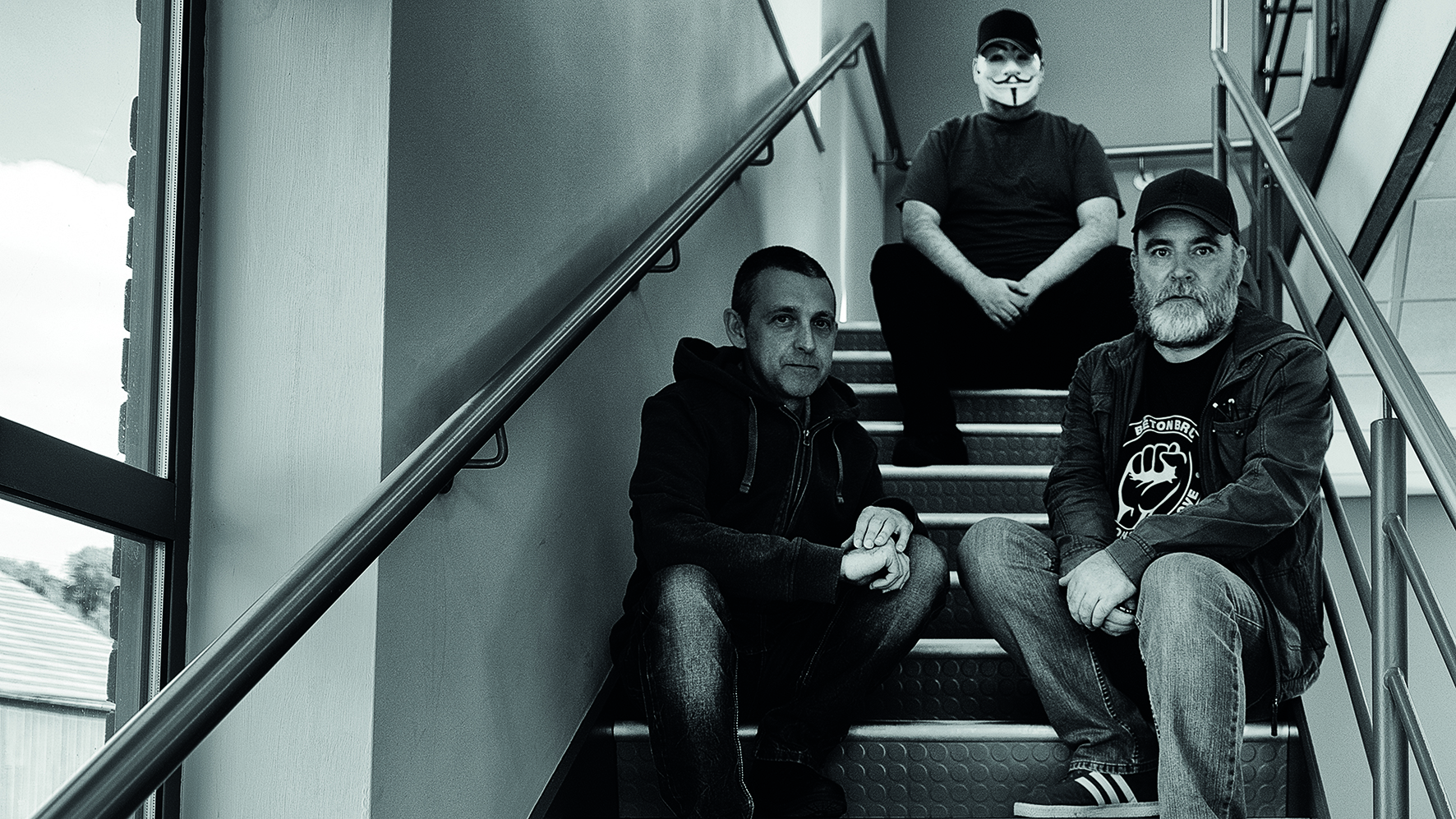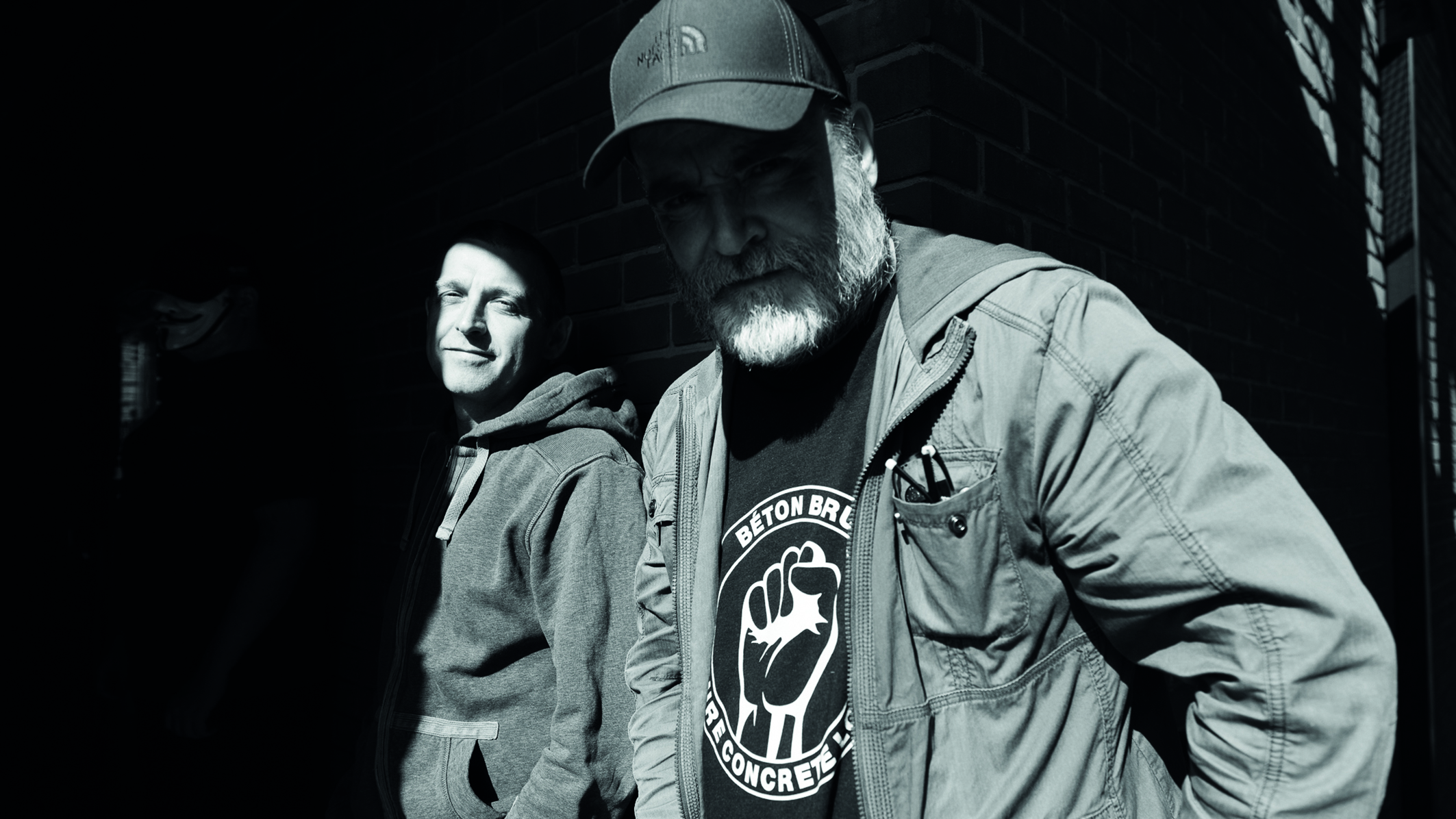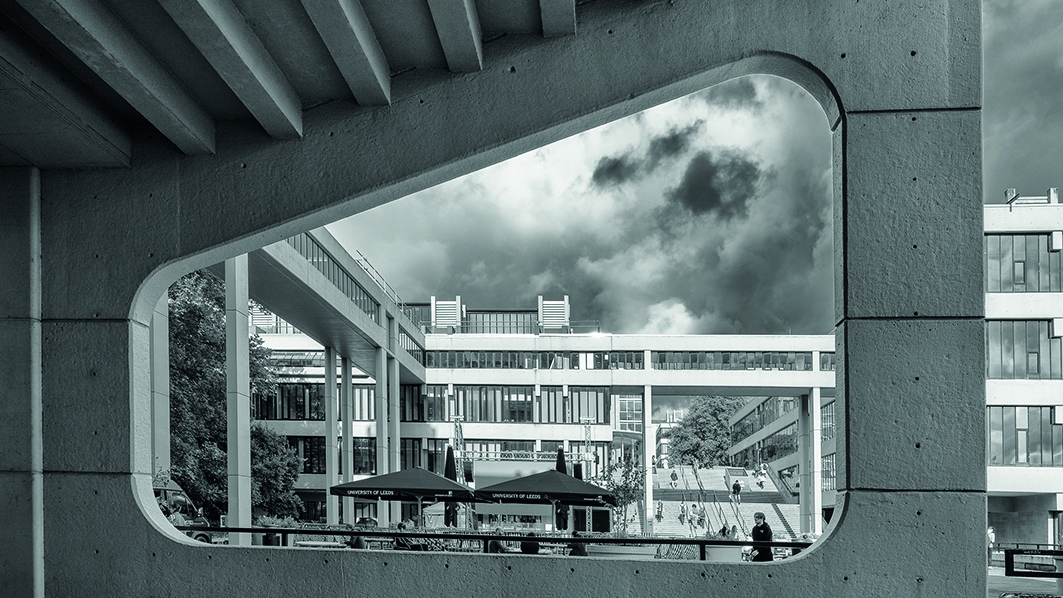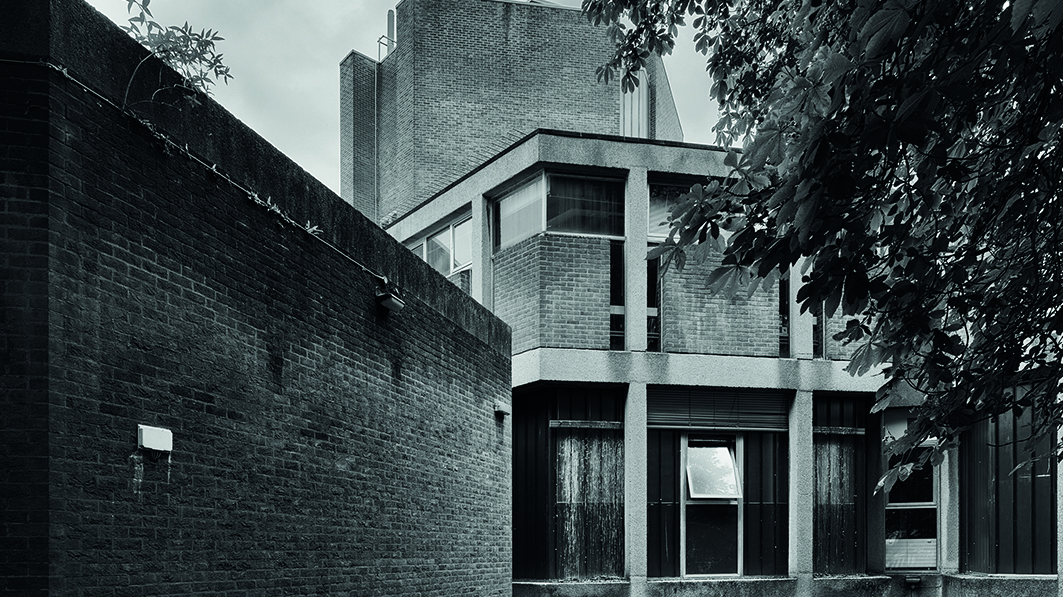The Black Dog: "We had all the OB8s and Roland stuff, but we just sampled the hell out of them and created our own libraries, so why have thirty grand’s worth of stuff that we bought off Phil Collins sat in the corner?"
Danny Turner meets the techno outfit to chat Sheffield, brutalism and new album Music for Photographers

Sheffield’s best-known purveyors of ‘listening techno’, The Black Dog hypnotised the electronic world with seminal ’90s albums such as Bytes and Spanners.
With the line-up changing from its initial formation, the last two decades have seen founding member Ken Downie joining forces with Martin and Richard Dust, with the trio treating us to a raft of unnervingly esoteric albums since the release of Silenced in 2005.
Away from the music, over the last few years Martin Dust has leaned in on his history in graphic design and reached for his camera to photograph various aesthetically pleasing concrete structures in Sheffield.
Initially set to a series of gritty, atmospheric EPs titled Dubs and accompanying booklet Brutal Sheffield, the project was so successful that The Black Dog went one step further to create the more nuanced instrumental album, Music For Photographers.

To what extent did Sheffield’s music scene play into your psyche as budding musicians?
Martin Dust: “I’m different to Richard because I’m from the Cabaret Voltaire/Human League era, which had a massive influence on me. When I saw them live I didn’t understand how they were making the noises they were and where it came from.
"The other part, which sounds trivial but meant a lot as a kid, is that I remember buying two sets of tickets – one for U.K. Subs and another for Orchestral Manoeuvres in the Dark, with Joy Division supporting. I also remember coming out of the nightclub and seeing Cabaret Voltaire queuing for a bus [laughs].”
Want all the hottest music and gear news, reviews, deals, features and more, direct to your inbox? Sign up here.
Richard Dust: “I arrived just as the whole electronic dance music movement was beginning to drop into the mainstream. Warp Records was starting to show up, clubs were gravitating towards that sound and the rave scene was on the verge of kicking off.”
MD: “Just admit it, you liked Pet Shop Boys?”
RD: “Actually, their B-sides had a lot of obscure remixes from people you’d never heard of at the time. There was a local scene and I also remember Manchester being a big influence, but we were always aware of what was going on Sheffield.”
Synthpop bands like ABC and Heaven 17 also came from Sheffield. Is that electro-pop sound really reflective of the city?
MD: “The Human League’s first two albums struggled to make any money or break through and then Gary Numan came along and blew them all out of the water. That was a big wake-up call. Before ABC, the band was called Vice Versa and Martin Fry wasn’t the singer.
"He had the blonde hair but used to wear a big mohair jumper and played a single oscillator like Stockhausen. In Sheffield, we seem to have a ten-year rule where somebody makes it and a few others escape, but these days every deal you’re forced to sign is a full 360 and we know what our Spotify royalty cheques look like.”
Didn’t Gary Numan say he only got £37 from a million Spotify streams?
MD: “It roughly works out at £1,000 for a million plays, which is appalling. We’re hoping that somebody somewhere is inventing a better system, something involving Blockchain or NFTs, even though Spotify is Blockchain technology – you just can’t see it. I don’t know what the future is on that side, but there’s no future in having a million plays.”
Ken and I tend to make really noisy, dirty stuff that Rich cleans up and then we tell him to put it all back
RD: “The big companies have really got a stranglehold on things and Spotify is a good example in that the big labels pretend to represent their artists but are also negotiating shareholdings so they can cream money from the top. Somewhere down the chain their artists might get a cut, but independents are right at the bottom of the feeding chain and don’t get a look in.”
Martin, how has your experience of photographing around Sheffield fed into the latest Black Dog album Music for Photographers?
MD: “Basically, Sheffield’s punctuated by a large social housing estate called Park Hill and on the left-hand side the entertainment centre/car park has two of the largest brutalist buildings in the city. When modernism started to replace the Victorian slums, brutalism looked like the future because you couldn’t build those structures with bricks.
"It sounds really nerdy but there are some fantastic lines on brutalist buildings, which you wouldn’t say about modernist ones. People don’t like brutalism because they don’t understand it or they’ve not been pitched it properly, but there’s a beauty in grey.”

Richard, were you as involved on the photography side throughout this project?
RD: “Not so much because that’s Martin’s passion. He goes out and looks for what he wants and takes pictures, but that’s being fed back to us all the time. Some of that process he’s not entirely happy with, which is when Ken and I use it as a starting point for parts, ideas and setting the tone for the type of music we want to make.”
MD: “It’s been a weird process. For example, I’ve been to one church 20 times trying to get a picture of it without a fucking car in front of it – even at four o’clock in the morning. The point of us writing the music was to get me to slow down and spend more time on-site trying to find those creative lines.”
Earlier this year, you released the Dubs EPs. Is that where the idea for the book Brutal Sheffield originated?
MD: “We started by creating the Dubs EPs, which was 100 hand-stamped 12”s with a booklet, prints and a badge. We wanted to create a piece of art, so all the titles and tracks were about different areas of Sheffield. Then people started commenting more and more on the architecture and the stories, so we thought about making a book.
"Brutal Sheffield was such a runaway success that none of us could believe it and we started wondering if we should make books instead of music. Now we’re going to do a second book called Brutal Yorkshire to test the theory of whether the first book was just a fluke.”
We created the rule of not using any human voices – nothing that would pull you out of the music
RD: “Initially, the music on the Dubs EPs was about locations rather than photography, but as Martin started taking more and more photos, a conversation came up about making companion pieces or undertaking a project that would aid the photographic process. So Music for Photographers started developing over time as we were finishing the EPs.”
How has the recording process been different to how you’d normally work on an album?
MD: “We started doing recordings at these photographic locations and putting things together that way. We made Foley recordings and used Zooms for recording environmental stuff by putting them on objects so that they’d amplify people walking up steps, etc. We’ve not gone full Chris Watson yet with all the special microphone setups, but that might be coming.
"Because of the wind and the architecture of the buildings, a place like Park Hill, for example, cycles at around 60Hz and there’s a natural hum to it. We started using that, and then we created the rule of not using any human voices – nothing that would pull you out of the music. Then we’d use the MacBook Pro to bring stuff in, because sometimes I’d be waiting three or four hours for the weather to change before I could take more photos.”

Did any aspects of that process derail you?
MD: “I’d written 18 extra tracks and sent them to Rich and Ken, but when I had a listen back they were absolutely miserable. You could’ve called that album ‘Music to Commit Suicide To’, but I associate that with the way the whole process was leaking through, from getting frustrated with having to keep going back to various locations to the weather being shit or being threatened with arrest for taking photos, twice.”
You had problems taking the photos?
MD: “As a photographer I find there’s two kinds of conversation you get into and the first one is ‘what are you taking a picture of that for?’ That’s usually a friendly conversation because they’re enquiring and I’d tell them that I’m looking at social housing and brutalist architecture in its setting and the beauty of everyday objects, but one guy threatened to knock my block off because he was upset that I was taking a picture of his home. I think he’d been drinking.”
Is that when the police got involved?
MD: “No, that was in Doncaster where they’ve got a fantastic brutalist court and police station. It’s a really run down precinct with a great car park, but the police immediately came out to me and lied, saying I needed permission to be there and had to book it in.”
I’ve always wanted to create the perfect album. It’s what I strive for, but you’ve got to be drop dead lucky
Is it tricky to get the intention of the music right when three of you are working on the music in tandem?
MD: “I don’t think so, as we always have set rules for our music projects. We’ve got loads of folders containing pieces of music we wrote for Music for Photographers that didn’t conform, but we tend to use mood boards, pictures and video and have shared access to all that information.
"When you have three creative people working on music it can get derailed quickly by the person who’s got the most time, but there’s not many arguments. Ken and I tend to make really noisy, dirty stuff that Rich cleans up and then we tell him to put it all back. Overall though, it works for us, as we all come from a creative background.”
Despite working collectively, will you tend to compartmentalise certain skills?
RD: “There’s a bit of a mish-mash of stuff going on, especially at first when we’re creating lots of ideas using little loops and samples. All of that stuff goes into the Google cloud and we all dip into that and have the freedom to mix and match whatever we want.
"Half of the time a lot of it never gets used, but something I throw away Martin might pick up, find interesting and start working on. It’s a very backwards/forwards approach, and only when we have full tracks do I start thinking about taking the track away from a rough demo and start to clean and shape it.”
MD: “When that’s done, Ken and I tend to work on the running order and I still do that old thing of burning stuff to CD and having a drive or a walk to listen to the album as a continuous piece of music. I’ve always wanted to create the perfect album. It’s what I strive for, but you’ve got to be drop dead lucky – like The Human League’s Dare, there’s not a shit track on it; it just works.”
RD: “I don’t think anybody ever delivers an album and actually thinks they’ve achieved that. With everything you do, you’re always left thinking there’s something missing or it’s not quite right.”
MD: “And you don’t get to decide, which is weird. I don’t want it to happen either, because if you make the perfect album what do you do then? It may be old-fashioned, but I still believe in an album being an experience and love creating objects.”

Is it important for you to all use the same music-making tools to achieve a consistent sound palette?
MD: “We’re all working in Ableton and the stock plugins like Simpler and Sampler are really straightforward. We also work with a lot of audio files, so we’re continually flattening and rendering stuff out, whether they’re stems, loops of an entire idea or some kind of sound bed or texture we’ve been working on. So we’re throwing these audio files backwards and forwards all the time, which plays into how you generally use Ableton really well.”
RD: “We use a lot of the same outboard stuff and software like Massive X, Omnisphere, Helm, and Max for Live, and because we’ve got all the accompanying text and photos we can identify and define what music should go into what folder.”
You guys come from a hardware era but seem to have fully adapted to using software?
RD: “What’s attractive is having the simple ability to be able to save all your ideas, recall them later or just send them to someone else. Obviously, we couldn’t do that with a hardware setup, but we’d still have to record it and end up transferring the audio files anyway.”
Whether it’s pissing it down or sunny, I can fire the MacBook Pro up, get my small Akai keyboard out and write music in the back of a car.
MD: “We had all the OB-8s and Roland stuff, but we just sampled the hell out of them and created our own libraries, so why have thirty grand’s worth of stuff that we bought off Phil Collins sat in the corner? We’d plug it in and smell the dust burning, so we found it better to invest in small plugin companies and do it that way.
"Whether it’s pissing it down or sunny, I can fire the MacBook Pro up, get my small Akai keyboard out and write music in the back of a car. That’s something we learned from our album Music For Airports, which was almost exclusively written while sat waiting in airports, destroying Brian Eno’s dream of a false utopia.”
Has the pandemic interfered with your operations?
RD: “This is only the eighth time I’ve been in the same room with Rich in two years. It’s weird how we’ve not talked about this project much in person yet still been able to get things done, although on reflection I guess we’ve been doing that for 21 years.
"Otherwise, we’ve been waiting nine months for the vinyl, which has been weird because we usually finish the album on a real buzz and three months later everything’s out.
"This time, as we’ve had to wait such a long time, it’s arrested our creative process and meant we can’t leave this project to go on to the next one. God bless Record Store Day – everyone needs a Radiohead and Muppets album in green vinyl.”
You seem to have been completely inspired by combining audio with visual arts. What comes next?
MD: “The photography’s opened up another world. People have asked us to do exhibitions, which really played to our ego until we realised we’d have to pay two and a half grand just to kit everything out and put it on a wall.
"We’ve also started creating a live audio-visual version of the album with Amoeba Design taking our photographs and manipulating them alongside a three-screen live show that we performed recently at the No Bounds Festival.
"They’re also working on pitching a full, wraparound 360 degree version, which is all really interesting and new because it takes us into different environments and we get to meet different people.”
The Black Dog's new album Music for Photographers is out now on Dust Science.


Future Music is the number one magazine for today's producers. Packed with technique and technology we'll help you make great new music. All-access artist interviews, in-depth gear reviews, essential production tutorials and much more. Every marvellous monthly edition features reliable reviews of the latest and greatest hardware and software technology and techniques, unparalleled advice, in-depth interviews, sensational free samples and so much more to improve the experience and outcome of your music-making.
